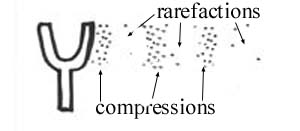What does our mental model of pressure tell us about what a vibrating
object does when it is in the air?

|
Compression: where the medium is more compressed than normal.
|
|
Frequency: How many compressions pass by a given spot in
one second ("cycles per second" or Hertz or Hz).
Amplitude: How compressed each compression is (or how "stretched
out" each rarefaction is).
|
Speed of sound is 330 meters/second or 740 miles/hour in air.
It needs some medium and travels better in liquids and solids.
Sound can be reflected and/or absorbed (turned to heat).
Natural frequency: the special frequency at which an object vibrates. Bigger, more massive things tend to vibrate slower and produce a lower pitch.
Some things to research (not covered in class or included on the test):
Doppler effect: the apparent change in pitch when an a sound source is moving toward you (raised pitch) or away from you (lower pitch)
Sonic boom!
©2006 Jeff Goodman
Back to ASU Elementary School Science Home Page